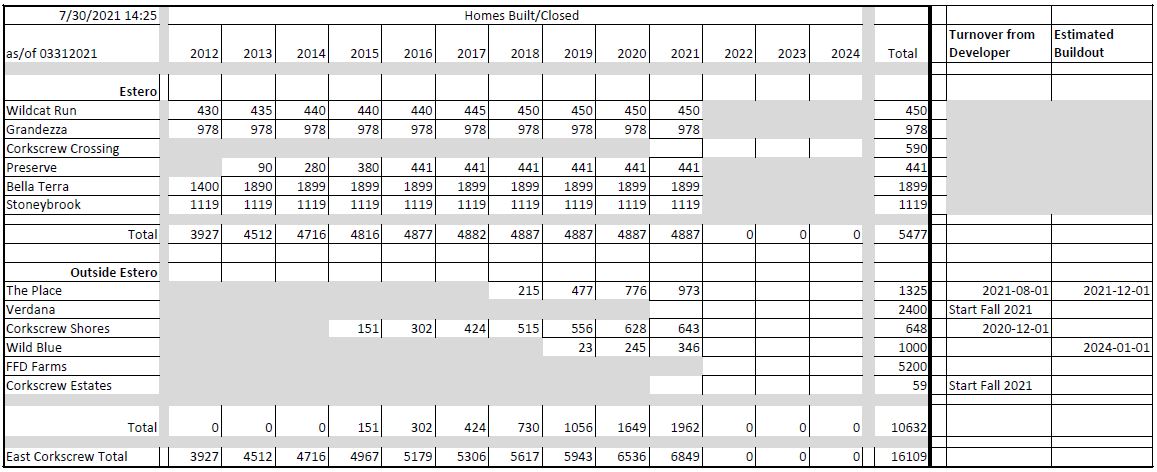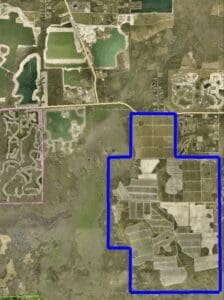5 things to know about new housing along Corkscrew Road
Why The Controversy?
The state sued Lee County in 1990 to protect drinking water, sparking controversy over new housing communities along Corkscrew Road. Many studies over the years led to an environmental strategy in which a Density Reduction/Groundwater Resource area protects below-ground aquifers by limiting construction above to one home per 10 acres.
County planners and developers later birthed a different approach, in where one home can be built for every acre. To do it, developers must find ways to reorient farmland so that the water flows the way nature intended and not for the convenience of orange trees. If the county agrees with the plan, developers can get a 10-fold density increase
Critics say the county did not insist on enough protection.
What’s In The Pipeline?
Wild Blue, the first of a series of developments in the region, is entering its marketing phase. The plan: 1,100 homes will be constructed over 2,960 acres near Alico Road.
The Place at Corkscrew, formerly known as Corkscrew Farms, received approval for 1,325 homes on as many acres. Builders are constructing the homes, and Camaratta Companies reports strong sales.
Another 1,460 homes approved for Corkscrew Road, has links to another nearby project
700-unit development OK’d in southeast Lee
Lee County approves 1,000 homes at Wild Blue
Commission give OK for Corkscrew Farms
Pepperland Ranch is a 700-home complex. County approval is in hand and development is in the final planning phases.
Verdana is the most recent, a 1,460-home community that runs from Corkscrew Road to the Collier County line.
What Else Is Out There?
Several limestone mines. They are used to contribute the raw materials for roads, homes and businesses. Two major rock mines are in line for permits. One is at the site of the Troyer Brothers potato farm. The other is a citrus farm now operated by King Ranch, a huge agriculture business.
A county hearing examiner will make recommendations soon, then the political hot potato heads to county commissioners.
What Used To Be There?
Panthers and other wildlife roamed and water flowed its natural path.
After several freezes devastated the citrus industry in the 1980s, orange, grapefruit and lemon growing moved south and changed the ways the water flowed.
The last nine miles of Corkscrew Road were so bumpy that school buses couldn’t make the trip. As a result, children had to be taken to the bus stop.
While residents are eager to see Corkscrew Road widened, it was only a generation ago that the road was first paved after a hard-fought battle waged by an earlier group of residents. It cost $2.9 million to pave the last segment.
What’s Ahead?
At a groundbreaking ceremony when the last segment of the road was paved, Lee County Commissioner John Albion looked to the future:
“This is going to be a very important roadway in the next 20 years, mark my words,” Albion said in 1994.
Reflecting on that comment a quarter century later, Albion, now a commercial real estate broker, looks ahead.
“Candidly it was fairly obvious then, it is a very important area and it will become more important. Without Corkscrew Road does Miromar build an outlet mall? Many people in Lee County know that Corkscrew Road is the shortest district from U.S. 41 to Interstate 75.
I project that between the end of 2018 and 2025, developers will build approximately $550 million in commercial real estate west of the railroad tracks.
The data above provides the information on the number of homes in the various communities on East Corkscrew Road (East of Ben Hill Griffin), updated as of July 2021. There has been a significant increase in the number of homes on East Corkscrew. When all the homes are completed the total number will be a further 66% higher than the 2020 figure. The ECCL tracks this data and updates quarterly on our website under the Safety Council.



